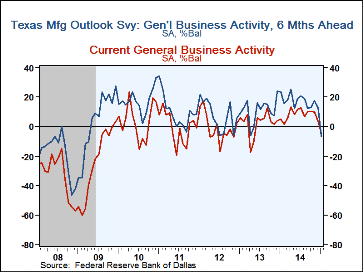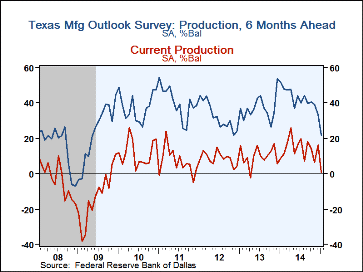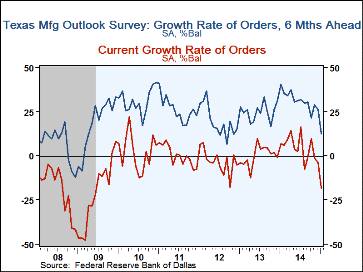 Global| Jan 26 2015
Global| Jan 26 2015Dallas Fed Factory Sector Activity Weakens
by:Tom Moeller
|in:Economy in Brief
Summary
The Federal Reserve Bank of Dallas reported that its January Composite index of factory sector activity of -4.4 was negative for the first time since May 2013. The figure reflected weakness amongst all of the component series, most [...]
The Federal Reserve Bank of Dallas reported that its January Composite index of factory sector activity of -4.4 was negative for the first time since May 2013. The figure reflected weakness amongst all of the component series, most notably the growth rate of new orders which collapsed to -18.0. That was its weakest reading since the end of the recession in June of 2009. The production index value of 0.7 was its lowest figure since April 2013. Wages & benefits turned sharply lower to the lowest since October 2013. Employment, however, was off just slightly at 9.0. Pricing power also evaporated. The index reading of prices received for finished goods turned to a negative 6.7, the weakest reading since May 2013 and raw materials pricing collapsed with lower commodity prices.
The business outlook fared no better. The business activity reading for six months ahead, at -6.4, was its first negative figure since May 2013 and the lowest reading since the recession. The company outlook figure similarly stalled, but remained a positive 2.5 versus 35.5 twelve months ago. The future production figure dropped to 22.1, its weakest reading since the end of the recession. Expected new orders growth at 12.9 was its weakest figure since September 2012. The same weakening was noted on the labor front with wages expected in six months dropping to 28.2, the easiest figure since June 2012. The expected workweek ticked up into positive territory, but at 0.7 was off versus 26.5 in December 2013.
The diffusion indexes are calculated as the percentage of total respondents reporting increases minus the percentage reporting declines. Firms are asked whether output, employment, orders, prices and other indicators increased, decreased or remained unchanged over the previous month. The data can be found in Haver's SURVEYS database.
The Inflation Expectations of Firms: What Do They Look Like, Are They Accurate, and Do They Matter? from the Federal Reserve Bank of Atlanta is available here.
| Dallas Federal Reserve Manufacturing Survey (SA, Percent Balance) | Jan | Dec | Nov | Jan '14 | 2014 | 2013 | 2012 |
|---|---|---|---|---|---|---|---|
| General Business Activity Versus One Month Ago | -4.4 | 3.5 | 10.1 | 5.0 | 8.3 | 2.2 | -0.6 |
| Production | 0.7 | 16.4 | 6.5 | 9.1 | 14.6 | 9.8 | 8.7 |
| Growth Rate of New Orders | -18.0 | -4.0 | -1.0 | 7.1 | 4.7 | 0.1 | -2.8 |
| Number of Employees | 9.0 | 10.0 | 10.3 | 9.5 | 11.5 | 5.6 | 11.8 |
| Prices Received for Finished Goods | -6.7 | 4.2 | 9.5 | 12.3 | 8.3 | 2.9 | 0.9 |
| Business Activity in Six Months | -6.4 | 13.0 | 17.7 | 23.3 | 17.4 | 11.0 | 7.6 |
| Production | 22.1 | 33.1 | 39.3 | 51.4 | 42.7 | 37.1 | 32.4 |
| Future New Orders Growth Rate | 12.9 | 26.2 | 28.8 | 48.1 | 39.6 | 34.3 | 29.5 |
| Wages & Benefits | 28.2 | 38.0 | 41.0 | 51.0 | 43.0 | 38.2 | 34.2 |
Tom Moeller
AuthorMore in Author Profile »Prior to joining Haver Analytics in 2000, Mr. Moeller worked as the Economist at Chancellor Capital Management from 1985 to 1999. There, he developed comprehensive economic forecasts and interpreted economic data for equity and fixed income portfolio managers. Also at Chancellor, Mr. Moeller worked as an equity analyst and was responsible for researching and rating companies in the economically sensitive automobile and housing industries for investment in Chancellor’s equity portfolio. Prior to joining Chancellor, Mr. Moeller was an Economist at Citibank from 1979 to 1984. He also analyzed pricing behavior in the metals industry for the Council on Wage and Price Stability in Washington, D.C. In 1999, Mr. Moeller received the award for most accurate forecast from the Forecasters' Club of New York. From 1990 to 1992 he was President of the New York Association for Business Economists. Mr. Moeller earned an M.B.A. in Finance from Fordham University, where he graduated in 1987. He holds a Bachelor of Arts in Economics from George Washington University.










